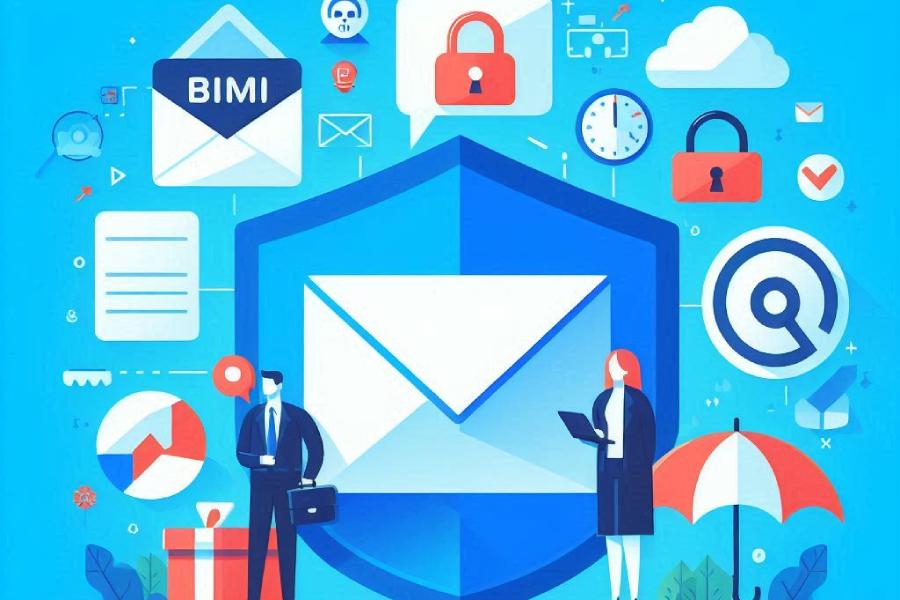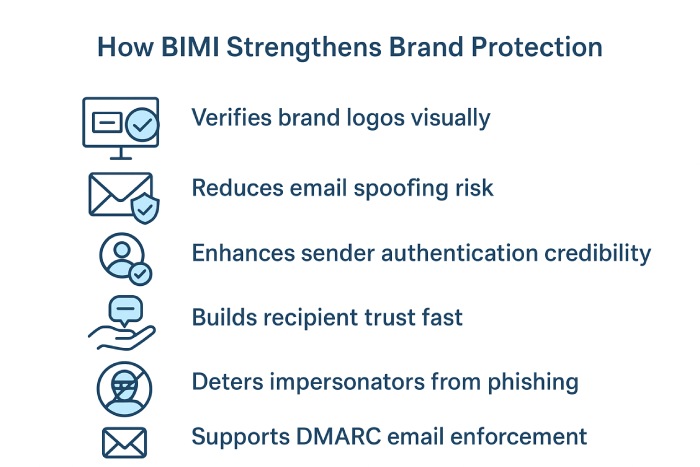How does BIMI enhance brand trust and offer protection to big companies?
Here’s something uncomfortable, but true: the more recognizable your brand becomes, the more exploitable it is.
And no, it’s not because your defences are weak. It’s because your identity is strong. Your tone, your visual language, your presence. There’s enough out there for someone to convincingly fake an email and send it off in your name. They can easily pick up on your brand’s tone, visual identity, and even typical subject lines.
The right tone, a believable subject line, maybe a logo copied and pasted from your website—that’s all that’s needed for a phishing email to pass as legitimate. To the average recipient, there’s no red flag. It feels real. It looks real. And that’s the danger.
So what can you do when your greatest strength, that is, recognition, starts working against you? BIMI (Brand Indicators for Message Identification) addresses this exact problem. It helps you reinforce your brand credibility and build trust with your audience by displaying your logo next to the email.
For big companies, whose names carry both recognition and risk, this is more than just a visual cue or a marketing tactic. Let’s see how BIMI helps you stand out from the crowd for the right reasons.
What is BIMI, and is it important (especially for a brand like yours)?
BIMI is a standard that allows your official brand logo to appear next to your emails in the recipient’s inbox. At first glance, it might look like a branding upgrade, but it’s far more than that.
BIMI only works when your emails are properly authenticated using SPF, DKIM, and DMARC. That means your logo becomes a verified trust signal, not just a graphic.
When someone sees your logo in their inbox, they don’t just see a brand; they recognize it, they associate with it. It’s a strategy to trust. And in a time when spoofing has become painfully easy, that strategy is no longer optional.
BIMI helps you reclaim control over how your brand shows up in the recipient’s inbox. This means, with BIMI in place, your customer no longer has to second-guess opening the email or engage with something that they shouldn’t have.
Why does BIMI matter even more when you’re a big brand?
You might think that big brands don’t really need to reinforce their identity, after all, their name does it for them. But the truth is, they need it more than anyone else. This is because the attackers know that the moment your customers see an email coming from your brand (or even something that resembles your brand), they will engage with it without any apprehension.
But with BIMI in place and your official logo next to your emails, that familiarity works in your favour, not the attacker’s. Your emails don’t just look professional; they look verified. BIMI makes it harder for impersonators to slip through the cracks because, without the right authentication, they can’t display your logo. And for your customers, that one small visual confirmation is often all it takes to trust the message and engage confidently.
How does BIMI protect your brand from impersonators?
Let’s take a look at how BIMI protects your brand from attackers and impersonators:
Only verified senders can use your logo
BIMI is an authentication protocol, which means that it doesn’t display your logo just because your brand is well-known. It shows up only if the email passes strict authentication checks like SPF, DKIM, and DMARC. If a message fails these checks, the logo won’t be displayed. So even if an attacker mimics your name or tone, they won’t be able to use your visual identity to trick recipients.
It builds instant recognition
When customers see your verified logo next to your email, it creates a sense of familiarity and trust. Over time, they begin to expect it. That means when a spoofed message arrives, the one without the logo, they’re more likely to notice that something is not right. With BIMI, your audience gets used to the signs of legitimacy, which makes spotting phishing attacks easier.
It makes it difficult for attackers to spoof
Even though the attackers can easily mimic your tone, language, and even design elements, they can’t really get your logo to show up next to their spoofed emails. Since their emails will not pass authentication tests like SPF, DKIM, and DMARC, BIMI will not allow your official logo to be displayed. This prevents your readers from engaging with a fraudulent email and falling prey to a phishing attack.
Regardless of your brand’s size, to reinforce trust and credibility with your audience, you must demonstrate that you are in control of your communication. BIMI helps you do exactly that. If you need help implementing BIMI for your brand, DuoCircle can guide you every step of the way—contact us today!”



